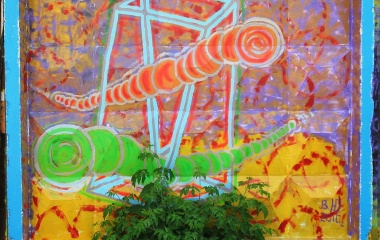What is a Mongolian Death Worm?
Deep beneath the sand in the wildest pockets of the Gobi Desert, the Mongolian Death Worm slumbers through most of the year. When the oversized worm emerges in June and July, travelers who stray through its territory put themselves in peril of a sudden, painful death.
Characteristics
Physical Description
Despite its name, the Mongolian Death Worm is very different from the slimy, soft-bodied creatures that the word “worm” usually brings to mind.
For starters, these desert monsters are super-sized. They can be anything from two feet to ten feet in length, and they can be as wide as an oak tree. Their skin, too, is dramatically different from a worm’s skin. They are plated with tough, red armor that helps them withstand the heat and friction of the desert sand. Their cavernous mouths are line with hooked teeth that help them drag prey into their throats.
Of course, the monster does have a few similarities to your garden-variety worm. Its body is long and tube-like, and it has no identifiable eyes or nose. Its body might also be segmented, like an earthworm.
Special Abilities
The fact that this enormous creature can survive in the barren Gobi Desert is, in itself, a miracle. Several important adaptations help the worm take on the desert’s toughest conditions. First, it is an excellent burrower, able to dig down to layers of sand that haven’t ben super-heated by the glaring desert sun. Second, the worm spends a large part of the year hibernating. In this way, it avoids the driest seasons and saves its energy for better days.
Still more astonishing than the Mongolian Death Worm’s ability to live is its ability to kill. This bizarre creature has some rare and deadly tricks for bringing down prey. It can send electric shock waves through the sand, stunning its victims so they can’t run when it emerges to eat them alive. It also has an acidic venom, so potent that it can corrode metal. Merely brushing its skin can deliver enough venom to kill you—and if it can’t get close enough to touch you, it can spit its terrible venom at you.
Cultural Representation
Origin
It’s unclear exactly how old the legend of the Mongolian Death Worm is. Tales of a monster worm buried under the sand of the Gobi desert were first introduced to the western world by an explorer named Roy Chapman Andrews in 1926. Although Andrews dismissed the stories as folklore, other scientists and explorers were captivated by this sensational creature.
Mongolian Death Worm sightings increased as its fame in the western world increased. The worm was used as inspiration in pulp fiction novels, and multiple expeditions were launched in the Gobi Desert to find the monster. All of the expeditions were forced to leave the desert empty-handed.
As the Death Worm’s novelty wore off, it’s popularity tapered too. Today, it has fallen into the chasms of public oblivion.
Explanation
Most biologists agree that the existence of a large, man-eating worm in the Gobi Desert is unlikely. The Gobi Desert is an extremely hostile environment, and few large animals manage to carve out a niche there. Plus, if the creature did exist, bones or bodies would have probably been found by now. With its hot, dry air, the Gobi Desert is excellent at preserving bodies, and the people who wander its sandy dunes no that they can get a large cash reward for bringing back the remains of a Death Worm.
The most likely explanation for the Death Worm is misidentification of real animals. Sand boas or worm lizards, which can grow to be several feet long, could be mistaken for monsters, especially by a traveler who is suffering from thirst or heat exhaustion under the scorching sun.










